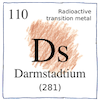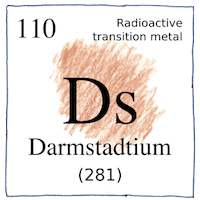Darmstadt—Sigurd Hofmann,
Gottfried Münzenberg,
Peter Armbruster,
H. Folger,
Fritz Peter Heßberger,
H. J. Schött,
Victor Ninov
elements

|
Darmstadtium
The team at Darmstadt bombarded lead-208 with nickel-62 nuclei to produce one atom of darmstadtium-269 and one free neutron. 208 plus 62, take away 1, leaves 269, having 110 protons and 159 neutrons. The team deduced the existence of the transient darmstadtium atom by detecting an alpha decay resulting in hassium-265. 269 take away 4 (an alpha particle has two protons and two neutrons) leaves 265, having 108 protons and 157 neutrons.
Atomic number 110
It would have been eka-platinum following Mendeleev’s naming convention. Before it had been synthesized, it was supposed to be ununnilium according to the 1979 IUPAC recommendation, although most people preferred element 110. The Russians wanted to name it becquerelium after Henri Becquerel. The Americans wanted to name it hahnium after Otto Hahn. The Germans named it darmstadtium after the town where they worked.
No standard weight
The standard atomic weight of a chemical element is the weight of its most common stable isotope, which doesn’t work well for elements with no stable or common isotope. The book says “extremely radioactive.” If someone you knew were this unstable, I’m sorry; I hope you weren’t very close.



The math is simple; however, the equipment to produce and accelerate heavy nuclei and to detect the results is not simple.
See also in The book of science:
Readings in wikipedia:
Other readings: